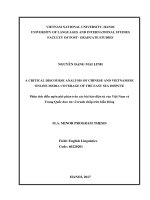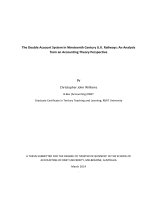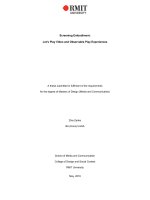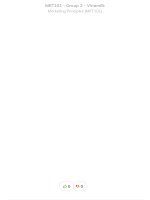BGE design analysis
Bạn đang xem bản rút gọn của tài liệu. Xem và tải ngay bản đầy đủ của tài liệu tại đây (115.16 KB, 3 trang )
Design Analysis
Designing plastic parts is a complex task involving many factors that address a list of
requirements of the application. “How is the part to be used?” “How does it fit to other parts in the
assembly?” “What loads will it experience in use?” In addition to functional and structural issues,
processing issues play a large role in the design of an injection molded plastic part. How the
molten plastic enters, fills, and cools within the cavity to form the part largely drives what form the
features in that part must take. Adhering to some basic rules of injection molded part design will
result in a part that, in addition to being easier to manufacture and assemble, will typically be
much stronger in service. Dividing a part into basic groups will help you to build your part in a
logical manner while minimizing molding problems. As a part is developed, always keep in mind
how the part is molded and what you can do to minimize stress.
Stress
The main enemy of any injection molded plastic part is stress. When a plastic resin (which
contains long strains of molecules) is melted in preparation for molding, the molecular bonds are
temporarily broken due to the heat and shear force of the extruder, allowing the molecules to flow
into the mold. Using pressure, the resin is forced into the mold filling in every feature, crack and
crevice of the mold. As the molecules are pushed through each feature, they are forced to bend,
turn and distort to form the shape of the part. Turning hard or sharp corners exerts more stress on
the molecule than taking gentle turns with generous radii. Abrupt transitions from one feature to
another are also difficult for the molecules to fill and form to.
As the material cools and the molecular bonds re-link the resin into its rigid form, these stresses
are in effect locked into the part. Part stresses can cause warpage, sink marks, cracking,
premature failure and other problems.
While some stresses in an injection molded part are to be expected, you should design your parts
with as much consideration for stress reduction as possible. Some ways to do this are by adding
smooth transitions between features and using rounds and fillets in possible high stress areas.
Wall Thickness
Determining the best wall thickness is an important decision that is driven by several factors.
Functional Requirements of the Part:
If you need a lot of strength and stiffness, you may choose to make your nominal wall thicker.
You can also make your walls stiffer by adding ribs.
Uniform Wall: Maintaining a nominal wall in your base feature will assure you of good resin flow
through the mold. Typically, your nominal wall shouldn’t vary more than +/- 10%. Sometimes a
complex part may require a varying thickness to meet the functional requirements of the part. Try
to avoid this, because this variation can cause major problems in mold filling and part warpage.
Since the hot plastic will always follow the path of least resistance (flowing into more open areas
as opposed to smaller, tighter areas), the thinner walls of your part may not fill properly. The
molder can increase the injection pressure to force the thinner areas to fill, however, this can
build even more stress into the part causing warpage. This is particularly the case with plastics
that have a higher mold shrinkage factor.
Alternatives: If your part is so complex that you need variations on your wall thickness, look for
an alternative. You may want to use design features such as coring or using ribs. At the very
least, try not to make the transitions between thicker and thinner sections too abrupt. Try using a
gradual transition or chamfered corners to minimize the dramatic change in pressures inside the
mold.
Molding Considerations
The thinner the nominal wall, the shorter the distance hot melt can flow before it solidifies or
“freezes off”. The flow length is dependent on material since different resins have different melt,
flow, and freezing characteristics. If your analysis shows that you need a particularly thick wall to
satisfy your structural requirements, perhaps upgrading your material to a stiffer variety will help
you to reduce your nominal wall. Also, additives such as glass fibers can increase stiffness of a
part with the same nominal wall. But bear in mind, these additives can also affect the flow and
shrinkage characteristics of the material and thus make your part design more difficult as
opposed to easier.
Draft
Most plastic parts include features such as outside walls and internal ribs that are formed by
opposing surfaces of tool metal inside a closed mold. To properly release the part when the mold
opens, the side walls of the mold are tapered in the direction that the mold opens. This tapering is
referred to as “draft in the line of draw”. This draft allows the part to break free of the mold as
soon as the mold opens. The amount of draft required can depend on the surface finish of the
mold. A smooth, polished tool surface will allow the part to eject with less draft than a standard
tool surface.
Sink Marks
When the hot melt flows into the mold, the thick sections don’t cool as fast as the rest of the part
because the thicker material becomes insulated by the outside surface of faster cooling plastic.
As the inner core cools, it shrinks at a different rate than the already cooled outer skin. This
difference on cooling rates causes the thick section to draw inward and create a sink mark on the
outside surface of the part. In addition to being unattractive, the mark also represents added
stress that is built into the part.
Parting Lines
A “parting line” is the line of separation on the part where the two halves of the mold meet. The
line actually indicates the parting “plane” that passes through the part. While on simple parts this
plane can be a simple, flat surface, it is often a complex form that traces the perimeter of the part
around the various features that make up the part’s outer “silhouette”. Part lines can also occur
where any two pieces of a mold meet. This can include side action pins, tool inserts and shutoffs.
Parting lines cannot be avoided; every part has them. Keep in mind when designing your part,
that the melt will always flow towards the parting line because it is the easiest place for the
displaced air to escape or “vent”.
Keep these factors in mind when designing your injection molded part, and remember that it is
easier to avoid problems in the beginning than change your design down the line.









